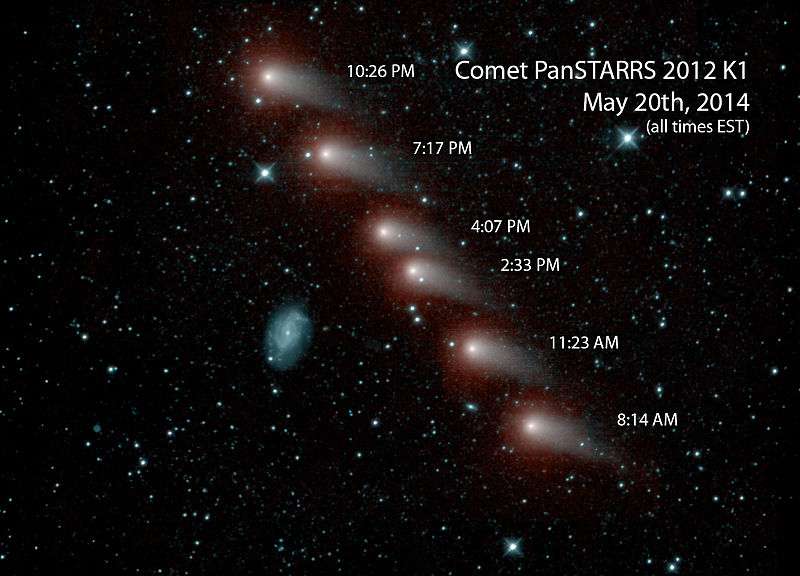February 22, 2016 report
Scientists measure methyl alcohol emission from comet C/2012 K1 (PanSTARRS)

Tomasz Nowakowski
astronomy writer

(�鶹��Ժ)—An international team of researchers led by Martin Cordiner of NASA's Goddard Space Flight Center has conducted measurements of CH3OH (methanol) emission from comet C/2012 K1 (PanSTARRS) that could yield invaluable information about cometary compositions and provide insights on the formation of our solar system. The results were published online on Feb. 16 in the .
For their measurements, the researchers employed the Atacama Large Millimeter/submillimeter Array (ALMA), located in the Atacama desert, Chile. ALMA, thanks to its unprecedented resolution and sensitivity, was previously used to study the distributions of HCN (hydrogen cyanide), HNC (hydrogen isocyanide) and H2CO (formaldehyde) in the inner comae of comets C/2012 F6 (Lemmon) and C/2012 S1 (ISON). Now, the facility obtained new information on the distribution and temperature of methanol in the inner coma of comet C/2012 K1 (PanSTARRS). The observations were conducted on June 28-29, 2014, when the comet was very bright (magnitude 8.5), visible through a small telescope and even binoculars, and relatively near Earth at a distance of nearly two astronomical units (AU).
"ALMA was used to obtain measurements of spatially and spectrally resolved CH3OH emission from comet C/2012 K1 (PanSTARRS). (…) Detection of 12-14 emission lines of CH3OH on each day permitted the derivation of spatially-resolved rotational temperature profiles (averaged along the line of sight), for the innermost 5,000 km of the coma," the scientists wrote in a research paper.
C/2012 K1 (PanSTARRS) is an Oort cloud comet that was discovered on May 17, 2012 using the Pan-STARRS telescope located on the island of Maui in Hawaii. The comet came to perihelion on Aug. 27, 2014 at a distance of 1.05 AU from the sun. Thus, the summer of 2014 offered astronomers a great chance to observe this icy planetesimal in detail.
Comets are believed to be frozen leftovers from the formation of the solar system around 4.5 billion years ago. They are relatively pristine and therefore may hold clues to how the solar system was made. Finding an organic compound like methanol on a comet hints that these icy bodies could have been a source of the complex organic molecules necessary for life.
Methanol, thanks to its abundance in comets and its complex energy level structure is an easily detectable molecule for probing the cometary coma temperature at radio and submillimeter wavelengths. ALMA observations of methanol emission at millimeter and submillimeter wavelengths have permitted Cordiner's team to conduct the first instantaneous, spatially resolved 2-D measurements of the coma's rotational temperatures. They detected large variations in the methanol rotational temperature in C/2012 K1 (PanSTARRS) over distances of about 1,000 kilometers (sky-projected distance), likely caused by changes in the coma kinetic temperature, mainly due to adiabatic cooling, and heating through solar irradiation.
"This study demonstrates that spatial temperature variations may need to be considered when deriving coma molecular abundances from spectral line data," the researchers concluded.
The scientists called for further high resolution observations and modelling that could yield better information about the coma thermal physics and molecular excitation, and assist in more accurate determination of cometary compositions. They also also emphasized that there is still a lack of understanding concerning the physical and chemical structure of the near-nucleus cometary coma at distances less than a few thousand kilometers from the nucleus.
Written for you by our author —this article is the result of careful human work. We rely on readers like you to keep independent science journalism alive. If this reporting matters to you, please consider a (especially monthly). You'll get an ad-free account as a thank-you.
More information: Measuring the Distribution and Excitation of Cometary CH3OH Using ALMA, arXiv:1602.03488 [astro-ph.EP]
Abstract
The Atacama Large Millimeter/submillimeter Array (ALMA) was used to obtain measurements of spatially and spectrally resolved CH3OH emission from comet C/2012 K1 (PanSTARRS) on 28-29 June 2014. Detection of 12-14 emission lines of CH3OH on each day permitted the derivation of spatially-resolved rotational temperature profiles (averaged along the line of sight), for the innermost 5000 km of the coma. On each day, the CH3OH distribution was centrally peaked and approximately consistent with spherically symmetric, uniform outflow. The azimuthally-averaged CH3OH rotational temperature (Trot) as a function of sky-projected nucleocentric distance (ρ), fell by about 40 K between ρ=0 and 2500 km on 28 June, whereas on 29 June, Trot fell by about 50 K between ρ=0 km and 1500 km. A remarkable (∼50 K) rise in Trot at ρ=1500-2500 km on 29 June was not present on 28 June. The observed variations in CH3OH rotational temperature are interpreted primarily as a result of variations in the coma kinetic temperature due to adiabatic cooling, and heating through Solar irradiation, but collisional and radiative non-LTE excitation processes also play a role.
© 2016 �鶹��Ժ





















